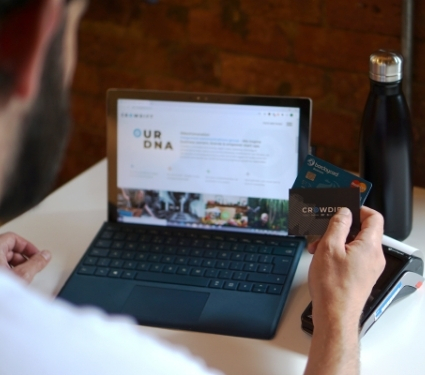How to start selling online
9-minute read
If you’re looking at how to start selling online, read on. And check out our guide to social media for small businesses too. Read this article to find out about things like ecommerce strategies and picking the right payment gateway, or call 0800029486 to talk through your plans with our payment experts.

In today’s world, online selling sites are often critical to business success, whether you’re selling a product or a service. In fact, in the UK, 77% of consumers say that they have bought more products online since the beginning of the pandemic.1
Whether you’re starting a business from scratch or moving your business online, this guide is for you.
The first step we’ve outlined is relevant for anyone thinking about selling online for the first time. After that we’ve focused on how to do this through your own website, rather than an online marketplace. We’ve also assumed you’ve done all the legal stuff, like registering your business with Companies House if it’s brand new.
If you’re in a rush, here are the four things we’ll cover in this guide to selling online.
How do I start selling online?
- Don’t take another step before you’ve written down your ecommerce strategy
- Choose an online selling platform and payment gateway that’ll grow with your business, not just one that suits you now
- Design and build an amazing customer journey
- Build your brand before you build your website
So, let’s go into these in more detail:
1. Have a crystal-clear ecommerce strategy
As tempting as it may be to just get selling when you’re excited about your product, or you need a new revenue stream quickly, the crucial first step to successful online selling is knowing exactly what you plan to achieve. Your ecommerce strategy doesn’t have to be long, complicated, or full of business jargon though. Quite the opposite, in fact. Write down answers to the following questions and you’ve got yourself the bones of a strategy that you can flesh out before you launch (or re-launch) your website:
- What am I going to sell and does my product/service lend itself well to being sold online?
- How many people want what I’m selling? This is crucial – it’s so important to understand the market for your product or service. Be honest with yourself at this stage and it’ll save you battling to find customers if, realistically, there are very few
- What are my customer demographics? This will not only help you understand what they’re looking for but also inform your pricing decisions
- How much will I charge customers? A good place to start here is by asking yourself ‘How much does it cost me to buy/make/offer my product?’ The answer to this will give you your margin
- What’s my customer’s buying behaviour and how will they find out about my website? Get clued up about ecommerce trends, e.g. will they find you on mobile, via apps, on social media platforms, etc? Social media will likely be a huge part of this, so read our guide to social media for small businesses
- Who are my competitors and what do I do that’s better/different? Understanding your unique selling point (USP) is a business basic, because if you’re offering exactly the same product, at the same price and with the same customer service and delivery options as an established player, you’re potentially fighting a losing battle. Your USP might be that you’re the cheapest, your product or service is of the highest quality, your customer service is superior, or your online payment journey is the smoothest. Whatever it is, know it inside out and make sure your customers know it too.
- How much do I need to sell to break even, make a profit and grow the business? Your sales targets and growth predictions are really important. If you don’t know your numbers you could get yourself into seriously deep water financially. Watch an episode or two of that popular show where inventors ask for investment and you’ll see what we mean
This isn’t everything, but it’s a great start and should get you thinking about whether or not you’re ready to start selling online.
Independent businesses are run by some of the most entrepreneurial people and their quick-thinking adaptability in the face of adversity is honestly breathtaking
2. Choose your online selling platform and payment gateway
Now you have your ecommerce strategy, it’s time to work out how best to start selling online. Think of the two options – hosted and self-hosted2 – as the equivalent of renting or owning a house. A hosted platform basically means you are renting your online store from a company. A self-hosted platform means you own that online store. There are pros and cons for each, as you’d expect:
Hosted: The good stuff
- As soon as you sign up, you’ll have the beginnings of your online shop. You’ll be able to choose from templates, basic functions and optional extras to add on – you don’t need to know much about ecommerce at all
- If you find yourself stuck on something, most hosted platforms have a support system in place – some are better than others, so do your homework on what the package gives you
- Being constrained by templates and functions can be a great way to stick to a tight budget, or even help you set budgets upfront
Hosted: The drawbacks
- Like renting a house, being on a hosted platform means you won’t necessarily be able to redecorate to your tastes. So, if you don’t like the design templates offered by your host, or it doesn’t support the online payment system you want to use, there’s very little you can do about it
- You won’t know if or when changes or updates are coming – and you’re certainly not in control of what those will be. You’ll also be tied in to the platform for a certain amount of time
Self-hosted: The good stuff
You get to do whatever you want; make your website look exactly like you want it to, with whatever functions you choose. There are no limits, except your budget and imagination
Self hosted: The drawbacks
- It’s more expensive than the hosted option and in order to brief web designers and developers effectively, it’s really important to understand the mechanics of getting a new website up and running
- If something goes wrong, it’s up to you to fix it and if you don’t know how, getting someone in who does can be pricey
As with most things in life, you get what you pay for. Whatever your budget, it’s important to work with reliable and trusted experts from web design and build, to choosing the right online payment system. Whether you’re starting a new business or adapting from being a physical-premises-only business, to one that’s either solely online or has multiple revenue streams, you need to think about your customer’s shopping and payment journey. Choose carefully from the website design and build, and payment providers on offer – in both cases, look for reliability, experience, expertise and support.
Your decision should be based on your stock size, skill level in terms of customising the website and understanding its functions, your budget, the level of support you think you’ll need, and the online payment gateway you want to use.
Creating a website that will convert browsers to buyers
There are loads of things that affect conversion rates, but a trustworthy, seamlessly integrated online payment system is arguably the most important. Just as with the hosted/self-hosted decision, we’d strongly advise you not to skip the homework on this one. The likelihood is that no matter who your customers are, they’ll want the choice of making digital payments and debit/credit card payments, as well as ‘buy now, pay later’ and ‘pay in instalments’ options.
So where does the payment gateway come in?
The role of an online payment gateway, processor or solution is to approve a credit or debit card transaction in real time. Think of it as the middleman between your online shop, the customer’s bank or credit card company, and your business bank account.
If that middleman goes off sick you’re in trouble. So, make sure you go with an online payment system and provider who can help you minimise problems and fix them quickly and seamlessly if they do occur. Fraud is a big problem to consider – in 2019, UK businesses suffered a huge £359m in fraud losses.3 £1.6m of those losses were due to COVID scams in just April 20204, so it’s essential to make sure you’re complying with current security regulations.
What security regulations do I need to know about?
PCI DSS
PCI DSS, which stands for Payment Card Industry Data Security Standard is basically about understanding exactly how and why you collect and store customer payment information. No one wants to put their customers’ online security at risk, and if a data breach does happen and you’re found not to be PCI DSS compliant, you may well be fined. Read our guide to PCI DSS here.
SCA (Strong Customer Authentication)
SCA is a key part of the latest Payment Services Directive (PSD2) and aims to make buying online more secure. It’s also known as two-factor authentication and it will require some customers to take extra steps to confirm their identity when shopping online. Read our quick guide to PSD2 and SCA.
So what questions should I ask when shopping for an online payment system?
- Can the system be easily integrated into my choice of website platform and can I customise it to fit with the look of my site? More on the importance of a consistent brand, later
- Is the system that’s provided secure and backed by a name my customers will know and trust?
- Will I get fraud prevention and security measures?
- Will I get regular reports to help me manage my online business?
Clue: Your chosen provider should be able to answer ‘yes’ to all of the above.

3. Design and build an amazing customer journey
You might have an incredible product or service, but if your customer service is shoddy, your delivery strategy is non-existent or your payment platform is hard to use, you’re in for a rocky ecommerce ride.
Put yourself in your customers’ shoes
Thinking about each step of the customer journey and how you can build trust with visitors, is critical to the success (or failure) of your website. Don’t just rely on the strength of your product or service. Consider:
- What your website looks like and how it performs across different devices – this is about far more than a responsive website that adjusts its proportions to fit different screen sizes. It’s about how willing customers are to fill in extensive login, billing and delivery details if they’re on a mobile rather than a laptop or desktop. It’s about how much scrolling customers must do to find the right information, or how many clicks it takes to complete a purchase. If you’re not catering for every device, you might find yourself missing out on potential sales.
- How customers can ‘check out’ – this means the steps it takes from choosing to buy a product, to adding it to a basket, picking delivery options and paying for it. Is this process as easy and quick as it could be? According to Statista, the global shopping cart abandonment rate in 2019 was 69.57%.5 The same research shows that 10% of shoppers abandon their carts because there isn’t enough choice of ways to pay and 17% because of security concerns at the checkout stage. That’s why your choice of payment platform is such a critical one when it comes to selling online successfully.
- Security and a name you can trust – customers are wary of identity theft, so make sure you choose a reputable online payment system. Most people will want to choose how they pay, so it’s important that your website accepts credit and debit card payments, as well as digital payments like PayPal and buy now, pay later (or in instalments), like Klarna. Making clear what you do and don’t accept at the start of the process should help reduce abandonment rates.
- Are your delivery options as good as they could be? We’re an impatient lot, which means we expect several delivery options depending on how urgently we need something. If you can offer free standard delivery all the way through to same day delivery (not for free, of course) then you might be pretty popular with thrifty and last-minute shoppers alike
- The consistency of your website – is the look and feel of your site the same throughout the customer journey, from landing on a blog, home page or product page all the way to payment confirmation? A disconnect between any one of these steps can deter customers and potentially turn them off their purchase. Design, tone of voice and functionality all play a part here. Which brings us on to your brand…
4. Building your brand
A brand is anything that separates one thing from another. This could be a symbol (like the famous sportswear brand’s swoosh), name (insert your favourite brand name here), emotion (think fizzy drink ads), tone of voice, and much more.
According to Crowdify Global, 91% of consumers would rather buy from an authentic brand, 60% of millennial consumers expect a consistent brand across all channels and consistent branding leads to an average revenue increase of 33%. 6
Becoming a brand is a huge part of successful online selling. After all, your customers can’t see you, can’t walk back into your shop to complain, ask for a refund or browse around – it’s all done in a virtual world. Your brand is the online equivalent of your high street shop front and friendly shopkeeper, so it’s really worth investing time and money into your brand story, brand design and tone of voice.
And aside from your customers, potential investors will need to buy into your brand, too, if you’ve got any hope of securing that lovely cash injection you might be after as you look to grow, like Bad Brownie have.
Once you’ve got a website, never stop working on it – there will always be things you can be doing to make the online shopping experience better for your customers, in the hope of increasing conversion rates and attracting new shoppers. Keep in touch with your payments specialist, who can help keep you up to date on the top payment gateways and right payment systems for your business as it evolves.
1 https://www.sendcloud.co.uk/ecommerce-statistics/
2 https://resolve.digital/blog/posts/hosted-vs-self-hosted-ecommerce/
3 statista.com/statistics/286250/united-kingdom-uk-e-commerce-fraud-losses/
4 theguardian.com/world/2020/apr/04/fraudsters-exploiting-covid-19-fears-have-scammed-16m
5 https://www.statista.com/statistics/477804/online-shopping-cart-abandonment-rate-worldwide/
6 https://www.crowdifyglobal.co.uk/branding/

Thinking of taking your business online?
Talk to one of our payments specialists who can walk you through our range of online payment gateway systems and help you work out the best solution for your business.
Call 0808 115 8207
We're available Monday to Friday, 9am – 5pm.
Share this article